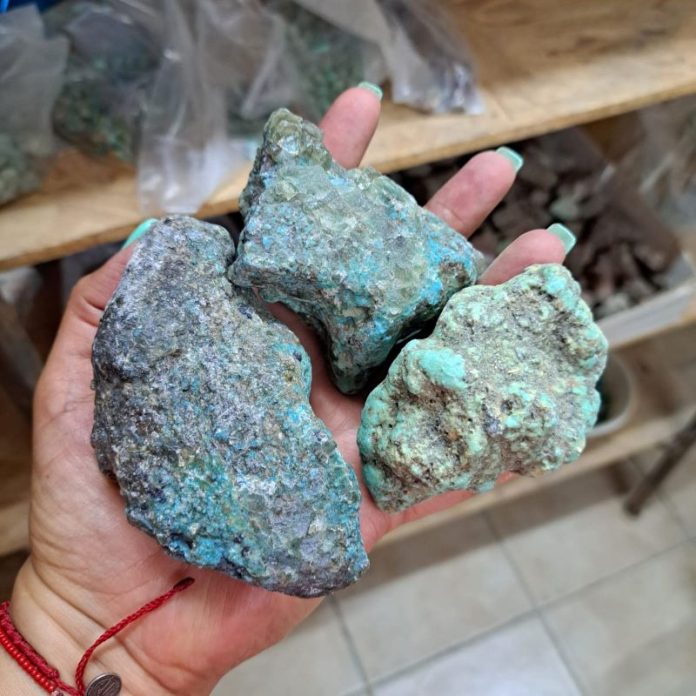
Campitos turquoise is found in the mountains of Sonora, Mexico. It’s a stone beloved by the native populations, and beyond, for countless generations.
It comes from the Cananea mines of that region of Mexico, some 35 miles from the U.S./Mexico border and approximately 150 miles southeast of Tucson, Arizona. Campito is a Spanish word that means “little field.”
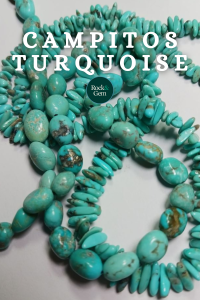
Sonora, Mexico
The State of Sonora is home to the Sierra Madre Occidental mountain range in the east; plains and rolling hills in the middle; and its west coast borders the Gulf of California. It has arid and semiarid deserts and grasslands. There are eight groups of indigenous Sonorans: the Mayo, Yaqui, Pima, Seri, Cucapá, Papago and Guarijio. The eighth group, the Kikapú, came to Sonora from Michigan about 100 years ago, according to explore-sonora.com. Agriculture, the cattle industry and tourism support the local economy.
How it’s Formed
What makes Campitos stand out from other turquoise varieties is how it forms. It is found in clay material as free-form nuggets 90 percent of the time and in rock veins the remaining 10 percent.
The presence of copper in Campitos helps give it its blue hue while iron is responsible for its shades of green.
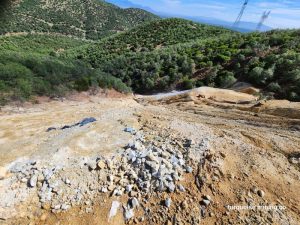
Courtesy Jorge Ruvalcaba.
Mining Campitos Turquoise
There are four pipelines in the area and Jorge Ruvalcaba’s family owns three of them. Government regulations must be followed, including the prohibition of heavy machinery in the mines.
“I grew up in Cananea, helping my dad and brother in the mines,” he said.
About 10 years ago, he assumed managerial duties. His children are also involved in the family business, Turquoise Mining Co. He travels extensively and also makes his home in Arizona. In addition to mining, the company drills stones, does cabbing, makes beads and offers a full line of jewelry.
“I changed the way we were working and expanded the business,” he explained. “We work with rough material, stabilized, dust and anything in between.”
Business is booming in the Campitos mines. On an average day, about 50 workers are on the ground, but that figure can climb to 200 people depending on demand.
A few years ago, he noted, about a ton of stone was extracted from the mines on a weekly basis. Today, that figure is more like 400 to 500 pounds a week.
“We work a mile up in the mountains in cooler temperatures surrounded by pine trees,” he said of the climate. “We (mine) from eight in the morning until three in the afternoon.”
Workers rely on smaller machinery to get the job done. How the turquoise is then processed after that depends on its hardness. The turquoise is cleaned in a mixer with water for about a half hour to an hour. If it’s still dirty after that, the material will be cleaned by hand.
Copper Deposits
Besides turquoise, the area is known for its rich copper deposits. But copper doesn’t interest Ruvalcaba.
“We leave the copper alone or put it on the dump site because it’s low-grade. It just doesn’t make financial sense (to process it),” he noted.
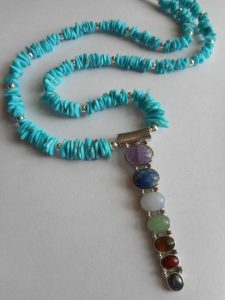
Courtesy Shauna Zeck.
Making Jewelry
Native American jewelry maker Shauna Zeck has used Campitos for the past 15 years for her BeadSpirit Designs.
“I enjoy working with it. It’s reasonably priced. It’s similar to a Sleeping Beauty turquoise and the higher quality Campitos definitely rivals the Sleeping Beauty mine,” she said.
She uses Campitos for making rings and cuffs and squash blossom necklaces, typically crafted using silver. She also incorporates the stone into her beadwork, teaming it with other types of turquoise and gemstones.
A Sacred Material
Turquoise is often seen as a symbol of good fortune. It was thought to protect against an untimely death in the days of the Persian Empire. The Egyptians associated the stone with Hathor, the goddess of beauty, love and the arts, with it reserved for wear by the nobility. Zuni and Pueblo peoples of the U.S. Southwest valued the stone, as did the pre-Columbian Aztec and Maya peoples. Turquoise is the traditional birthstone for December.
“Turquoise is a very sacred material, since the beginning of time, used in a lot of ceremonies of the Apache. I’ve always wondered what it would have been like to be the first person to discover it,” Zeck added.
She noted campitos turquoise contains naturally occurring pyrite, which accounts for the gray matrix that runs through some nuggets.
“The pyrite flecks make the stone sparkle,” she said. “My Auntie had told me that the pyrite flecks are rare and some think it makes it a higher quality stone.”
Zeck added that Campitos tends to be harder than other types of turquoise, but not necessarily heavier.
“Most turquoise ranks around 5 to 6 on the Mohs hardness scale with Campitos slightly higher at about 6 to 6.5,” she explained.
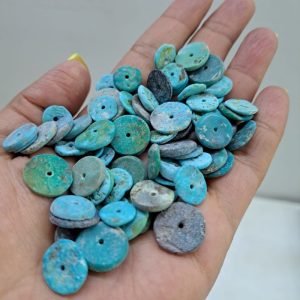
Courtesy Jorge Ruvalcaba.
Stabilized Turquoises
Ruvalcaba said low-grade turquoise is too soft to work with and is chalky in consistency and light in color. That variety is found more on the surface with harder stones to be had the deeper you go. In recent years, his company began selling jewelry and other finished products, but its primary customers are stabilizing companies based in the U.S.
Stabilization occurs when an epoxy resin is added to the turquoise, which is porous and absorbs the treatment, through pressure. The result is a harder stone with a more intense color, which is ready to be cut, polished and fashioned into jewelry and other accessories without the worry of it breaking down. When done correctly, stabilized stones are long-lasting and provide a more affordable alternative to higher-grade turquoise sold in its natural condition. In addition to stabilizing, turquoise is sometimes dyed or reconstituted.
It comes down to personal preference and what you’re willing to spend. It is illegal to sell turquoise as “natural” if it has undergone any of the previously mentioned alterations.
Popular Turquoise
Turquoise can be worn every day if you avoid it coming into contact with chemicals, cosmetics and skin oils. Store it away from other gemstones that may scratch its surface. Do not use ultrasonic cleaners and avoid getting it wet. Styles and trends change with the times. “I would say our seafoam nuggets that are popcorn-shaped have become a trademark of our turquoise,” Ruvalcaba said. “The clear, ice blue shade is popular too.” But supply and demand determines prices. Once seen as a stone of regional interest, Campitos has enjoyed success on the global scene at various rock and gem shows and conventions.
“It’s driven by the market. Right before the Tucson Gem and Mineral Show, for example, we see an increase in demand, then that goes down,” he noted.
Promoting Campitos on a variety of social media platforms has also helped propel it into the mainstream. Not bad for a stone that comes from a small region of northwest Mexico.
“People from the U.S. would come to buy it, but now it’s a global enterprise,” he said of its success.
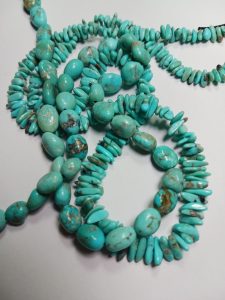
Courtesy Shauna Zeck.
Quality Control
Deciding what to keep and what to discard when mining has changed through the years, and likely for the better, Ruvalcaba noted. It’s hard to believe but it wasn’t until a few years ago that the green and yellow-hued Campitos turquoise was seen as a marketable commodity.
“We used to throw away a lot of material, such as the Sonoran gold turquoise. Nobody wanted it. We stabilized it and now it’s very famous,” he said.
According to the Gemological Institute of America (GIA), “Over the last 10 years, millions of carats of turquoise have been enhanced by a proprietary process called the Zachery treatment. Tests show that this process effectively improves a stone’s ability to take a good polish and may or may not improve a stone’s color. It also decreases the material’s porosity, limiting its tendency to absorb discoloring agents such as skin oils. Examination of numerous samples known to be treated by this process revealed that Zachery-treated turquoise has gemological properties that are similar to those of untreated natural turquoise and that the treatment does not involve impregnation with a polymer.”
The Sonoran variety hit the market in 2019/2020 and caught the eye of rockhounds thanks to the dramatic color variations not seen anywhere else. It has a yellow spiderweb matrix and varies in color from baby blue to lime green.
“The oxidation of the copper causes the color,” he added.
Zeck said Sonoran gold reminds her of gaspeite, which is a rare nickel carbonate mineral part of the calcite mineral group. It was first discovered on the Gaspe Peninsula of Quebec, Canada.
“Sonoran gold can really have that apple green color,” she added.
Ruvalcaba pointed out that the names of stones get changed on the market, so you may own Campitos turquoise and not even know it.
If you don’t yet have this unique stone in your collection, there’s still time to obtain it as the Campitos Mountains are bountiful.
“We have a lot of material. Everywhere you see, you find more. And we are always looking for new deposits. We have a long way to go before it’s depleted,” Ruvalcaba explained.
To learn more, he may be reached at: rjorgeruvalcaba@hotmail.com and through social media: www.facebook.com/Campitos-TurquoiseMine.
This story about Campitos turquoise previously appeared in Rock & Gem magazine. Click here to subscribe. Story by Sara Jordan-Heintz.












